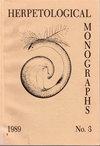Taxonomic Revision of Chironius bicarinatus (Wied 1820) (Serpentes: Colubridae), with Description of a New Species
IF 1
2区 生物学
Q3 ZOOLOGY
引用次数: 2
Abstract
Chironius bicarinatus is a conspicuous colubrid snake species, widely distributed in northeastern, southeastern, central-western, and southern Brazil, as well as Paraguay, Argentina, and Uruguay. On the basis of new morphological data of individuals from previously unsampled regions and deoxyribonucleic acid sequences, we reviewed the taxonomy of populations previously referred to as C. bicarinatus, revisiting the species definition with an updated diagnosis, inferring its phylogenetic relationships with closely related lineages in southern Brazil, herein described as a new species restricted to Pampa forests or grasslands and Atlantic Forest semidecidual forests in southern Brazil. The new species can be readily diagnosed from C. bicarinatus and all other congeners on the basis of internal (hemipenis unilobed, unicalyculate, cylindrical, apex with smooth calyces, with spinules restricted to proximal portion, near the medial area; lacrimal foramen with small projection on the anteroventral margin) and external morphology (ventrals 153–165 [153–165 in males, 155–164 in females]; subcaudals 103–146 pairs [129–142 in males, 103–146 in females]; adult dorsal pattern with dark green background, scales sometimes with light blue margin, two conspicuous black dorsal stripes with light green vertebral stripe between them that gradually dissipates to the tail, ventrals with black margin on its edges) and molecular evidence.文章标题大菱鲆(Chironius bicarinatus, 1820年编)的分类学修订(蛇纲:大菱鲆科)并附一新种描述
双鳍Chironius bicarinatus是一种引人注目的冷蛇,广泛分布在巴西东北部、东南部、中西部和南部,以及巴拉圭、阿根廷和乌拉圭。基于来自先前未采样区域的个体的新形态学数据和脱氧核糖核酸序列,我们回顾了以前被称为双卡氏菌的种群的分类学,通过更新的诊断重新审视了物种定义,推断了其与巴西南部密切相关谱系的系统发育关系,本文描述为一个新物种,局限于巴西南部的潘帕森林或草原和大西洋森林半死森林。根据内部(半阴茎单瓣、单钩状、圆柱形、顶端有光滑的杯状,小棘局限于近端,靠近内侧区域;泪孔在前腹侧边缘有小突起)和外部形态(腹面153-165[153-165名男性,155-164名女性];囊下103-146对【雄性129-142,雌性103-146】;成年背侧图案,背景为深绿色,鳞片有时有浅蓝色边缘,两条明显的黑色背侧条纹,中间有浅绿色脊椎条纹,逐渐消散到尾部,腹面边缘有黑色边缘)和分子证据。
本文章由计算机程序翻译,如有差异,请以英文原文为准。
求助全文
约1分钟内获得全文
求助全文
来源期刊

Herpetological Monographs
生物-动物学
CiteScore
5.40
自引率
0.00%
发文量
2
审稿时长
>12 weeks
期刊介绍:
Since 1982, Herpetological Monographs has been dedicated to original research about the biology, diversity, systematics and evolution of amphibians and reptiles. Herpetological Monographs is published annually as a supplement to Herpetologica and contains long research papers, manuscripts and special symposia that synthesize the latest scientific discoveries.
 求助内容:
求助内容: 应助结果提醒方式:
应助结果提醒方式:


